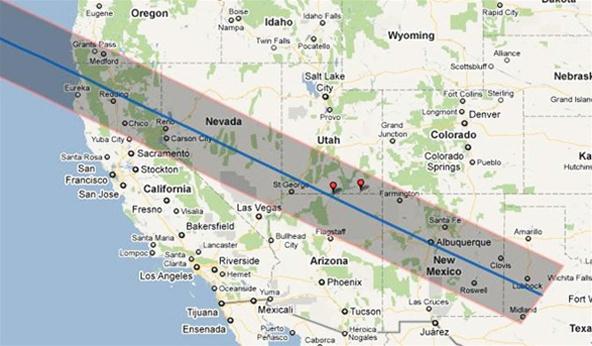Using a pinhole projection box that I created, I was able to view the solar eclipse without injuring my eyes. Even though the image was small and it wasn't a complete "ring of fire", it was still breathtaking. When I first heard about the annular eclipse, I immediately started doing research and tried to learn as much as I could about it. All that research made the experience of viewing the solar eclipse so much more enjoyable and made me appreciate the site more than I would have otherwise. It has always been my goal to view a solar eclipse, and I suppose my goal was fulfilled. That only means that my next goal is to view a total solar eclipse. Perhaps when I'm older, I will travel to an area where you are able to see that. Some day, it is my goal to go on a retreat of sorts to just view the wonders the sky. Today was just another step on my journey to learning about the sky.
This map shows where the full annular eclipse could have been seen. It is indicated by the gray area of the map.
Despite the fact I did not have an eclipse glasses, I used the alternative way of viewing it using a pinhole projection box. It didn't exactly look the best, but it did a pretty good job considering it was a box and piece of white paper. An alternative way of looking at it was projecting an image of the sun with a telescope or binoculars onto the ground. You could have also used a welder's mask #14. Despite how safe it may have seemed, looking at the sun through sunglasses or film is not safe and still causes eye damage. It may be better than staring at the sun with a naked eye, but it can still cause damage The safest way to view it is when the sun is projected onto a surface. I know that there's nothing you can do about it now that it's over, but I just thought it should be known for the next solar eclipse.
This was my pinhole projection box. It was just a box with a pinhole and a piece of white paper. Viewing the solar eclipse was as easy as aiming that box at the sun. It was simple and effective.
Here is the projection of the eclipse onto the paper. It wasn't exactly as big of a projection as I would have liked, but it was amazing nonetheless.


